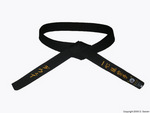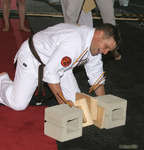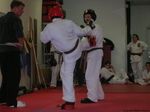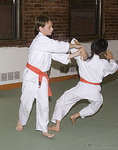This is a response I wrote to someone looking for good martial arts training for her twin 5 year olds.
Are they ready for martial arts?
Concentration, interest and attention really matter a lot more than age, though coordination helps as well. I've seen 5 year olds who are very serious about their karate and really work on getting it "just right" -- and also 9 year olds who bounce all over the place and while they're getting something out of the dojo, it's not really "martial arts". I knew my 5 year old daughter was ready to start martial arts when she went with me to an advanced karate class and sat and watched us for the entire hour.
My background
My own background is traditional Okinawian karate and Aikido though I've also studied Judo, Jujitsu, Brazilian Jujitsu, Tae kwon do and Tai Chi. I have very little direct experience with Kung Fu.
My two daughters both take Aikido and I'm also showing my younger one my style of karate on an "as interested" basis (she just naturally wants to kick, punch, strike, tackle and otherwise engage in personal mayhem more than the older one ever did, mostly with me as the target.)
I'm going to do a brain dump here -- please forgive me if I go over things you already know.
Selecting a School
First of all, I think the most important thing about any martial art is the quality of instruction and the general "energy" of the school. While various martial arts are very different, they're all working on very similar parts of the inner person. I'll make some general comments about various styles but instruction and energy overrides nearly all of them.
Look for something that works schedule wise -- the best school in the world won't do much if you can only bring them to class every 6 weeks. Twice a week is probably the minimum attendance to keep learning.
I suggest you contact the schools and find out when they hold kids classes -- then arrange to go observe at least 1/2 of the class and talk to the Sensei afterwards if possible.
A school should be welcoming and confident that they offer something of value. I think any school that won't let your kids attend a class or two before deciding to join should probably be left alone. One that tries to get you to "sign up for a 3 month membership and get a free gi" is betting that you won't stay 3 months unless they've already made you pay -- and there's probably a reason for their opinion.
Next I usually ask about promotions -- when they could expect to be promoted and the ever popular question "how long until they make black belt". "When they're ready" and "a long time from now" are, respectively, good answers. I studied Isshinryu karate for about 7 years in total as an adult before making black belt -- and it's not unusual to go even longer. Schools that estimate your 5 year olds will be 8 year old black belts tell me they don't think they have that much to teach.
Also, "guaranteed promotion" or "guaranteed testing" is a huge red flag -- how can they guarantee how well your kids will learn? Note that there are often separate testing fees so schools that do "guaranteed testing" are often guaranteeing themselves income. Testing fees in themselves are not a negative indicator but they explain the angle of schools that like to test a lot -- one school near me has something like 30 ranks and test every month. This type of place is often called a "McDojo".
Next, ask how many tournaments they go to, and if they're required, encouraged or completely optional. Some schools go to a lot of tournaments (about $50-$80 each entry fee). There's nothing inherently wrong with that and I do know some good schools that do many tournaments, but you want to know what you're getting in to. I also know many schools who are more into collecting trophies than teaching martial arts. Asking about tournaments is a good way to explore this issue. Many traditional schools never go to tournaments. (My own karate school attends local tournaments hosted by instructors who are personal friends of my Sensei -- 3 per year.) Schools that do a lot of tournaments often modify their art to do better in tournaments. In the extreme they're more into performance arts than martial arts.
Ask about application (bunkai), self-defense and/or sparring (kumite). Some schools love to spar, some never spar. (Some traditional schools don't spar on the grounds that they're supposed to be non-violent.) Sparring scares a lot of people. My own opinion is that martial arts is about interacting with other people and a school that doesn't teach you to apply it is just teaching you a fancy form of dance (Dance is fine -- I took ballet as a young boy, but it's not martial arts). "In theory there's no difference between theory and practice" is a good way to describe schools which teach martial arts with no physical interaction between students.
Sparring doesn't have to be (and shouldn't be, particularly for kids) any kind of hard sparring -- in fact, some schools say "we don't spar" but "we practice self defense techniques". The terminology doesn't matter as much as the fact that they do it. They key here is that you're learning not just about yourself and how you should move but you must apply that to a situation where you're interacting with someone else and matching your movements to theirs. Aikido and Judo do this interaction inherently. If an Aikido school says "we don't spar", that's no problem -- you can watch them tossing each other around in regular class. That's fine.
In karate and related arts, I think light sparring is appropriate even for young kids and low ranks. The key here is light -- no one should be feeling pain. It's a game, but one which teaches important lessons. Aside from the physical skills of movement with a partner, I believe that exploring a confrontation like situation in the training hall makes it less likely for a kid to get into it in the outside world. They seem to have the confidence that they know what to do and don't feel the need to prove it. Also, it is a great place to learn to separate emotion from physical actions. A good school makes sure that sparring never involves anger. OK, enough soap box on this one. You can probably tell I have a strong opinion here :)
On a side note, I personally enjoy heavy, continuous sparring. I don't do it with 5 year olds but they often do it with me. You learn different things from heavy sparring than from light sparring. Both are valuable. However, while "heavy sparring" means just that, you're still not trying to injure anyone.
Oh, while we're near the topic, some schools seem to break enough boards you'd think they were firewood factories. Some look at you funny and say "I've never been attacked by a tree" (that's a canned answer, of course). Board breaking is showy and does have some value but I don't put too much value on it either way unless they're completely obsessed with breaking wood.
Many schools, particularly traditional Japanese ones, emphasize their lineage and trace their heritage through specific people to either historical or current figures in Japan. I think that exact lineage is relatively unimportant and see being overly concerned with it as a bad sign. It provides some form of legitimacy but there are so many martial arts associations that I'm not sure how an outsider would judge the quality (and I include myself in that definition of "outsider" for everything but specifically Isshinryu karate.)
Now, on to...
Different Styles
"Karate" is a general term that basically means "kicking and punching". The extremes are "traditional" and "freestyle" -- most schools fall somewhere in between. If someone says "Okinawan" that probably means traditional. Karate originated (well, pretty much) in Okinawa and then migrated to Japan (more or less). If a school also mixes in something like Judo, all the better, but some people are purists. Tae kwon do is a Korean variant on kicking and punching but in its most common form (perhaps 95% of the schools) it's pretty much the sport of kickboxing. You might hear "Shorin-ryu" (most popular Okinawian style), "Shotokan" (Japanese style derived from Shorin-ryu), Shorei-ryu or many other names. Uechi-ryu is less suited for kids as traditionally it really emphasizes body conditioning -- these are the guys who can break 2x4s over their arms, not something you want to do with growing bones and joints -- but I've heard of some Uechi-ryu schools that modifed the style to work well for kids.
(Incidentally, the "ryu" suffix is Okinawan for "school" where "kan" is the Japanese suffix. "Do" (pronounced "doh") means, pretty much, "spiritual way" or "path to enlightenment" where "jitsu" means more or less "art" or "method". So, "ryu" or "kan" just identifies a particular variation. Someone who emphasizes "do" probably means that they want to emphasize some specific philosophy or position, e.g. "we study karate-do".)
Judo is, in most schools, the art of getting in close to someone and throwing them on the ground. It's great as an adult but I think 5 is a bit young for most of the Judo I've experienced. 5 year olds often don't have the control and judgment to practice Judo well without hurting people. (When you throw someone on the ground you have to make sure to do it so they can get back up. Calling the ambulance really slows down practice :) Now, one very good thing that kids can learn from Judo is "breakfalls" (ukemi). Of course, a karate school can teach this too (mine does) but they really come from Judo, Aikido or sometimes Jujitsu. Breakfalls are just that, and I've seen my own kids use them automatically and come up from what should be an orthodontia inducing fall with nothing more than a scrape because they just automatically go into a roll.
Aikido is, despite Steven Segal movies, really a pacifistic martial art. It's the art of getting out of the way and helping someone fall on the ground or lock their own joints. (It's really about energy manipulation with a bit of body mechanics thrown in.) There are no attacks taught in my Aikdio school other than to help someone else learn to respond -- it's all self defense. (I'll add that to a karate practitioner it's quite obvious that Aikido doesn't emphasize the attacks :)
Aikido practice is the most cooperative and nonconfrontational of any contact martial art. It also takes a very long time to learn. There are things you learn in karate that you just won't get in Aikido, but Aikido places a great deal of emphasis in some places where karate teaches very subtly.
Kung Fu is interesting -- it's actually a very broad term that effectively covers all the above from things which are basically punching and grabbing (Wing Chun -- what Bruce Lee initially studied) through very graceful martial dances (Shaolin Kung Fu). I've never personally had opportunity to study Kung Fu. Most Kung Fu styles seem to emphasize flexibility and mobility and seem to work better on long, willowy body types (I'm relatively short and thick.)
Conclusion
Well, I suspect I've buried you here in much more than asked for, but it seems like I've barely given you an overview :)
If you'd like more detail or clarity or further information, feel free to email or call.
[Author's Note: phone number removed. You web readers can email dewey@sasser.com ]
I hope this helps,
-
Dewey




